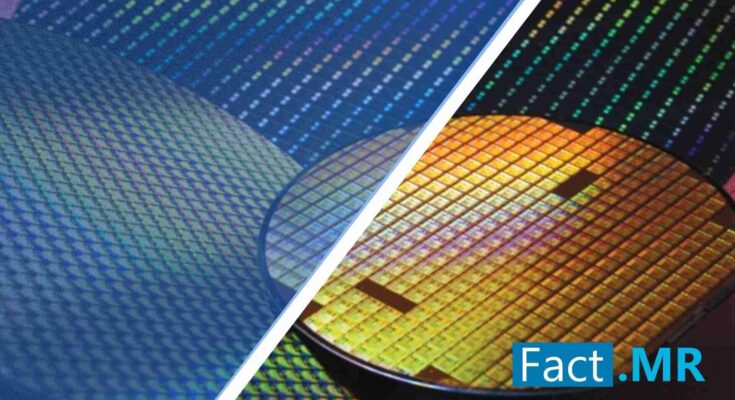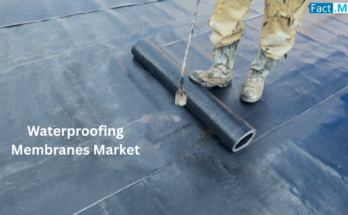As technology gets more complex, the pellicle industry plays a crucial role in protecting sensitive components. The challenge is to adapt pellicles to work with smaller devices, new lithography methods, and emerging technologies. As the semiconductor world changes, pellicles contribute to better device quality and performance, making their future an exciting journey of innovation and possibilities.
As per FACTMR, the global pellicle market is expected to witness a CAGR of 9.5% to reach US $ 1,719.8 Mn by the end of 2033. Various factors such as significant investments in R&D, and technological advancements are expected to contribute to the high growth of the market.
What does the Evolution of the Pellicle Market look like in Europe and Asia Pacific?
Europe Market
• In Europe, the pellicle market has evolved in alignment with the region’s strong presence in semiconductor research, development, and manufacturing. As semiconductor nodes continue to shrink, pushing the boundaries of lithography, the demand for high-quality pellicles has grown.
• Europe’s focus on innovation and technological advancement has led to the development of cutting-edge pellicle materials, designs, and manufacturing processes. Additionally, the region’s commitment to sustainability has spurred efforts to create environmentally friendly pellicle solutions.
• The market has seen collaboration between semiconductor manufacturers, research institutions, and material suppliers, fostering a vibrant ecosystem that shapes the future of pellicles in semiconductor manufacturing. Europe’s focus on technological innovation, coupled with its commitment to sustainability, positions it as a significant contributor to the development of pellicles that cater to the region’s semiconductor needs while aligning with global industry trends.
Asia Pacific Market
• In the Asia Pacific region, the evolution of the pellicle market is closely tied to its dominant position in semiconductor production. Countries like South Korea, Japan, Taiwan, and China have been instrumental in driving advancements in chip manufacturing technologies.
• As semiconductor nodes reach new levels of miniaturization, the need for pellicles to protect photomasks from contaminants has become critical. Asia Pacific’s massive manufacturing infrastructure, investments in research and development, and strong industry partnerships have propelled the growth of the pellicle market. The region’s focus on mass production while maintaining high quality has resulted in the development of efficient and reliable pellicle solutions that cater to the semiconductor industry’s demanding requirements.
• As semiconductor technology progresses and miniaturizes, the demand for effective pellicles to safeguard sensitive photomasks increases. Asia Pacific’s dedication to technological advancement, robust manufacturing capabilities, and strategic investments positions it as a driving force in shaping the pellicle market’s trajectory within the semiconductor industry.
Overall, in both Europe and the Asia Pacific, the evolution of the pellicle market involves a blend of innovation, collaboration, technological progress, and responsiveness to the evolving needs of semiconductor manufacturing. These regions continue to contribute significantly to advancing the role of pellicles in ensuring the quality and precision of semiconductor devices.
Eminent Player’s Key Stratagems
Mitsu Chemicals America (OTCMKTS: MITUY), SHIN-ETSU, Micro Lithography, S&S Tech, Fine Semitech Corp. (KOSDAQ: 036810), ASML Holding Inc., Teledyne DALSA, Inc., IMEC, and Canatu are the key players operating in the Pellicle market.
Manufacturers are continuously focusing on investing in research and development to innovate new products catering to diverse applications in semiconductor manufacturing. For instance, Samsung Electronics has started developing the advanced EUV Pellicle to counter its rival TSMC and gain a higher market share.
Sustainability is an ongoing trend in the pellicle market
Sustainability has a profound impact on the overall pellicle market. As industries worldwide shift towards environmentally responsible practices, the pellicle market is no exception. This transformative trend encompasses various aspects:
• Material Innovation: Sustainable materials are gaining traction, prompting manufacturers to explore alternatives such as bio-based polymers and recyclable options. These choices align with reduced environmental impact and lifecycle considerations. Moreover, sustainability-driven manufacturing practices are becoming prevalent. Companies are optimizing energy consumption, adopting clean technologies, and enhancing resource efficiency to minimize their ecological footprint.
• Lifecycle Approach: The adoption of circular economy principles is influencing pellicle design and manufacturing. Emphasis is placed on creating products that can be disassembled, reused, or recycled, thereby minimizing waste generation.
• Regulatory Adherence: Stringent environmental regulations necessitate sustainable approaches. Manufacturers must ensure compliance with these rules to ensure market access and uphold ethical standards.
• Customer Preferences: Environmentally conscious customers, including semiconductor manufacturers, prioritize suppliers that integrate sustainability. This demand drives companies to demonstrate eco-friendly practices throughout their supply chains.
• Innovation Pathways: Sustainability requirements stimulate innovation. Manufacturers are exploring novel solutions, such as water-based coatings and energy-efficient processes, to reduce their environmental impact.
• Long-Term Value: Sustainable practices offer enduring benefits. From reduced operational costs through efficient resource utilization to improved brand reputation and market differentiation, the value of sustainability is multifold.
• Collaborative Endeavors: Addressing sustainability challenges requires collective action. Industry partnerships, knowledge-sharing initiatives, and collaborative research expedite the implementation of environmentally responsible practices.
How to Reduce the Production Cost of Pellicles in Europe?
The pellicle market is facing various challenges due to high production costs. Moreover, this limits the semiconductor manufacturers which is ultimately limiting the consumption too. Reducing the production cost of pellicles in Europe involves a combination of strategic measures aimed at optimizing various aspects of the manufacturing process. Here are some strategies that can be considered:
• Material Selection and Sourcing: Evaluate different pellicle materials to identify cost-effective options without compromising quality. Collaborate with suppliers to negotiate favorable pricing for bulk purchases and explore alternative sourcing options.
• Efficient Manufacturing Processes: Streamline manufacturing workflows to minimize waste, reduce downtime, and improve overall efficiency. Implement lean manufacturing principles and continuous improvement methodologies to identify bottlenecks and optimize processes.
• Automation and Technology: Invest in automation and advanced manufacturing technologies to enhance productivity and reduce labor costs. Automation can help in precision manufacturing, minimizing errors, and increasing throughput.
• Energy Efficiency: Identify opportunities to reduce energy consumption during manufacturing, such as optimizing equipment usage, upgrading to energy-efficient machinery, and implementing energy-saving practices.
• Supply Chain Optimization: Collaborate closely with suppliers and partners to establish efficient supply chains, reducing lead times and minimizing transportation costs. Implement just-in-time inventory practices to avoid excess inventory expenses.
• Waste Reduction: Implement waste reduction strategies to minimize material wastage during manufacturing. Consider recycling or repurposing waste materials where feasible.
• Scale and Volume: Increase production volume to benefit from economies of scale. Higher production quantities often lead to reduced unit costs due to optimized resource utilization.
• Design for Manufacturability: Work closely with design teams to ensure that pellicles are designed for easy and cost-effective manufacturing. Simplifying designs can help in reducing production complexities and associated costs.




